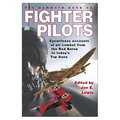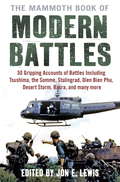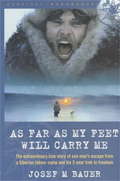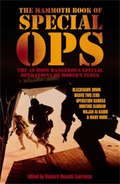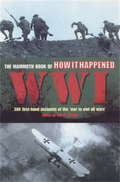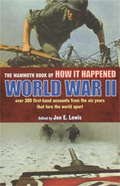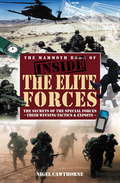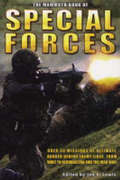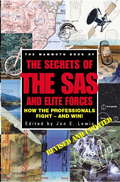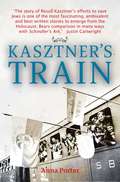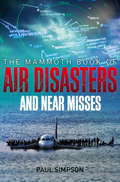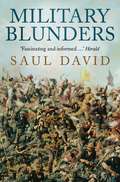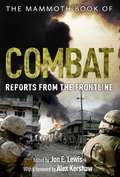- Table View
- List View
The Mammoth Book of Fighter Pilots: Eyewitness Accounts Of Air Combat From The Red Baron To Today's Top Guns (Mammoth Books)
by Jon E. LewisFrom yesteryear's flying aces to today's top guns, The Mammoth Book of Fighter Pilots presents, in the words of the combat pilots who fought them, fifty incredible air battles that have shaped military history in the twentieth century. Veteran anthologist Jon E. Lewis has assembled firsthand accounts from all the great military campaigns of aerial warfare, including World Wars I and II, the Spanish Civil War, Korea, Vietnam, the Falklands, the Gulf, and Bosnia. Page after exciting page of this singular collection brings into vivid play the exploits of such legendary pilots as Manfred von Richtofen, Eddie Rickenbacker, Douglas Bader, and Johnnie Johnson; the Luftwaffe World War II aces Heinz Knoke, Gerd Barkhorn, and Johannes Steinhoff; and forty other brave airmen from America, Britain, France, Japan, Russia, and North Korea. Here, too, are the planes in which these pilots flew into modern historythe Spitfire, the Mustang, the Me 109, the Zero, the F-16, the MiG, and the Harrier. Together with the death-defying drama of combat, this volume vividly captures other facets of the fighter pilot's life, including the perils of bailing out in enemy territory, the daily horrors of internment in a Japanese POW camp, and a harrowing account of being shot down in a blazing Spitfire. The true-life aerial combat adventures in this stirring collection provide a vicarious, adrenaline-fueled expedition into the shell-blasted skies of war in the twentieth century.
The Mammoth Book of Fighter Pilots (Mammoth Books #373)
by Jon E. LewisFrom yesteryear's flying aces to today's top guns...Veteran anthologist Jon E. Lewis has assembled firsthand accounts from all the great military campaigns of aerial warfare, including World Wars I and II, the Spanish Civil War, Korea, Vietnam, the Falklands, the Gulf, and Bosnia. Page after exciting page of this singular collection brings into vivid play the exploits of such legendary pilots as Manfred von Richtofen, Eddie Rickenbacker, Douglas Bader, and Johnnie Johnson; the Luftwaffe World War II aces Heinz Knoke, Gerd Barkhorn, and Johannes Steinhoff; and forty other brave airmen from America, Britain, France, Japan, Russia, and North Korea. Here, too, are the planes in which these pilots flew into modern historythe Spitfire, the Mustang, the Me 109, the Zero, the F-16, the MiG, and the Harrier. Together with the death-defying drama of combat, this volume vividly captures other facets of the fighter pilot's life, including the perils of bailing out in enemy territory, the daily horrors of internment in a Japanese POW camp, and a harrowing account of being shot down in a blazing Spitfire. The true-life aerial combat adventures in this stirring collection provide a vicarious, adrenaline-fueled expedition into the shell-blasted skies of war in the twentieth century.
The Mammoth Book of Modern Battles (Mammoth Books)
by Jon E. LewisFrom the start of the 20th century to the most recent major offensives, here are fifty accounts of the battles that made the modern world, described in superb detail by historians and writers including John Keegan, Alan Clark, John Strawson, Charles Mey, John Pimlott, and John Laffin.All the major conflicts are covered, from two world wars, through Korea, Vietnam, Bosnia, Chechnya, to Iraq and Afghanistan. Among the battles featured are: the Somme, Passchendaele, Battle of Britain, Stalingrad, El Alamein, Monte Cassino, Omaha Beach, Iwa Jima, Dien Bien Phu, Ia Drang, Hamburger Hill, Desert Storm, Kabul, Baghdad, and Basra.
The Mammoth Book of Modern Battles (Mammoth Books #381)
by Jon E. LewisFrom the start of the 20th century to the most recent major offensives, here are fifty accounts of the battles that made the modern world, described in superb detail by historians and writers including John Keegan, Alan Clark, John Strawson, Charles Mey, John Pimlott, and John Laffin.All the major conflicts are covered, from two world wars, through Korea, Vietnam, Bosnia, Chechnya, to Iraq and Afghanistan. Among the battles featured are: the Somme, Passchendaele, Battle of Britain, Stalingrad, El Alamein, Monte Cassino, Omaha Beach, Iwa Jima, Dien Bien Phu, Ia Drang, Hamburger Hill, Desert Storm, Kabul, Baghdad, and Basra.
As Far as My Feet Will Carry Me
by Josef M. BauerOriginally published in 1955, this must be one of the most dramatic adventures of our time. Clemens Forell, a German soldier, was sentenced to 25 years of forced labour in a Siberian lead mine after the Second World War. Rebelling against the brutality of the camp, Forell staged a daring escape, enduring an 8000-mile journey across the trackless wastes of Siberia, in some of the most treacherous and inhospitable conditions on earth.Bauer's writing brilliantly evokes Forell's desperation in the prison camp, and his struggle for survival and terror of recapture as he makes his way towards the Persian frontier and freedom.
The Mammoth Book of Special Ops
by Richard Russell LawrenceInto the eye of danger with the men who put the 'special' in special forcesThe once shadowy activities of special forces have grown into an increasingly exposed element of 21st century warfare and anti-terrorist activity. Here, in one giant unputdownable volume, are 30 of the most dangerous special operations of modern times.Drawn from the flashpoints of the world, and above all Iraq and Afghanistan, these first-hand and reported accounts of missions by the SAS, Delta Force, Green Beret, Commandos and other forces will leave you on the edge of your seat.The accounts include:? Blackhawk Down - the US Delta forces debacle in Mogadishu, Somalia, 1993? British Special forces fight Al Qaeda at close quarters in Afghanistan 2003? Task Force Raider - US Special forces teams track down Saddam Hussein, 2003? The British 'Blackhawk Down' - Paras shoot their way out of trouble in Majar, Iraq 2003? The capture of insurgent leader Chemical Evil Fat Mama, Fallujah, November 2003
The Mammoth Book of Special Ops (Mammoth Books #359)
by Richard Russell LawrenceInto the eye of danger with the men who put the 'special' in special forcesThe once shadowy activities of special forces have grown into an increasingly exposed element of 21st century warfare and anti-terrorist activity. Here, in one giant unputdownable volume, are 30 of the most dangerous special operations of modern times.Drawn from the flashpoints of the world, and above all Iraq and Afghanistan, these first-hand and reported accounts of missions by the SAS, Delta Force, Green Beret, Commandos and other forces will leave you on the edge of your seat.The accounts include: Blackhawk Down - the US Delta forces debacle in Mogadishu, Somalia, 1993 British Special forces fight Al Qaeda at close quarters in Afghanistan 2003 Task Force Raider - US Special forces teams track down Saddam Hussein, 2003 The British 'Blackhawk Down' - Paras shoot their way out of trouble in Majar, Iraq 2003 The capture of insurgent leader Chemical Evil Fat Mama, Fallujah, November 2003
The Mammoth Book of How it Happened: World War I
by Jon E. LewisThe spectre of the Great War still haunts us. No other conflict so dramatically illustrates the waste of life, and the slaughter of innocents, as that of 1914-18. And none has so dramatically shaped the modern world: the Russian Revolution, the rise of Hitler, the break-up of Empire, the supremacy of America and World War II all stem from the four years of the 'war to end all wars'. Here is the eye-witness chronicle of that war, from the trenches of Flanders to the staff rooms of the Imperial Germany Army, from T. E. Lawrence in the desert to the 'Red Baron' in the air, from Land Girls in England to German U-boat crews in the Atlantic, it leaves nothing out. And if all the horror of the war fought by the Tommies in the trenches is captured, so too are the machinations of the 'top brass' and politicians.
The Mammoth Book of How it Happened: World War I (Mammoth Books #378)
by Jon E. LewisThe spectre of the Great War still haunts us. No other conflict so dramatically illustrates the waste of life, and the slaughter of innocents, as that of 1914-18. And none has so dramatically shaped the modern world: the Russian Revolution, the rise of Hitler, the break-up of Empire, the supremacy of America and World War II all stem from the four years of the 'war to end all wars'. Here is the eye-witness chronicle of that war, from the trenches of Flanders to the staff rooms of the Imperial Germany Army, from T. E. Lawrence in the desert to the 'Red Baron' in the air, from Land Girls in England to German U-boat crews in the Atlantic, it leaves nothing out. And if all the horror of the war fought by the Tommies in the trenches is captured, so too are the machinations of the 'top brass' and politicians.
The Mammoth Book of How it Happened: World War II
by Jon E. LewisIn his account of World War II, historian Jon Lewis has selected 300 first-hand accounts, from Heinz Guderian rolling his panzer tank into Poland to VJ Day in London and New York. More than a eyewitness chronicle, this collection gives the reader an insight into how the repercussions from the war shaped our modern world, and how nothing from geo-politics to rock 'n' roll can really be understood without considering it.
The Mammoth Book of How it Happened: World War II (Mammoth Books #379)
by Jon E. LewisIn his account of World War II, historian Jon Lewis has selected 300 first-hand accounts, from Heinz Guderian rolling his panzer tank into Poland to VJ Day in London and New York. More than a eyewitness chronicle, this collection gives the reader an insight into how the repercussions from the war shaped our modern world, and how nothing from geo-politics to rock 'n' roll can really be understood without considering it.
The Mammoth Book of Inside the Elite Forces
by Nigel CawthorneThe most comprehensive and up-to-date guide to American and British special forces, covering all aspects of their equipment, training and deployment in the Iraq age of warfare. It takes a special kind of person to join the Special Forces and those to pass the stringent entrance requirements are subjected to the most rigorous training. They're trained to be super-fit, taught to survive in the most adverse conditions, and turned into killing machines. This book reveals what makes these men tick, and everything you need to know to become one of them. It covers all the types of training required - for fitness, combat, survival, navigation, communication, infiltration, interrogation, extraction and evasion. And it details the full array of weapons used, from small arms and knives to explosives and air back-up. Also included are full listings of all the units - including the SAS, Green Berets, SBS, Navy SEALs, Delta Force, Army Rangers - and their deployment in present-day conflicts such as Desert Storm, Somalia, Afghanistan, Iraq and anti-terrorist operations.
The Mammoth Book of Inside the Elite Forces (Mammoth Books #216)
by Nigel CawthorneThe most comprehensive and up-to-date guide to American and British special forces, covering all aspects of their equipment, training and deployment in the Iraq age of warfare. It takes a special kind of person to join the Special Forces and those to pass the stringent entrance requirements are subjected to the most rigorous training. They're trained to be super-fit, taught to survive in the most adverse conditions, and turned into killing machines. This book reveals what makes these men tick, and everything you need to know to become one of them. It covers all the types of training required - for fitness, combat, survival, navigation, communication, infiltration, interrogation, extraction and evasion. And it details the full array of weapons used, from small arms and knives to explosives and air back-up. Also included are full listings of all the units - including the SAS, Green Berets, SBS, Navy SEALs, Delta Force, Army Rangers - and their deployment in present-day conflicts such as Desert Storm, Somalia, Afghanistan, Iraq and anti-terrorist operations.
The Mammoth Book of SAS and Special Forces
by Jon E. LewisHere are thirty true and graphic accounts of the most heroic SAS and special-forces missions ever undertaken into the most dangerous place of all - behind enemy lines. Bang up to date, this unputdownable collection includes the most recent operations into Iraq in 2003, Afghanistan and Bosnia, and features the entire range of special forces from SAS, Commandos and Rangers to Navy SEALS and Paratroopers. Also included are several accounts that lift the veil - clandestine 'eyes-only' operations of ultimate danger, such as 1 SAS's attempted assassination of Rommel and 22 SAS's 'claret' raids into Indonesia in 1964. Each account is introduced by a mini-essay illustrating fascinating pieces of special-forces hardware, kit or training, such as SAS Evasion and Rescue training, the Accuracy International L96A1 sniper rifle and US Special Forces selection.
The Mammoth Book of SAS and Special Forces (Mammoth Books #386)
by Jon E. LewisHere are thirty true and graphic accounts of the most heroic SAS and special-forces missions ever undertaken into the most dangerous place of all - behind enemy lines. Bang up to date, this unputdownable collection includes the most recent operations into Iraq in 2003, Afghanistan and Bosnia, and features the entire range of special forces from SAS, Commandos and Rangers to Navy SEALS and Paratroopers. Also included are several accounts that lift the veil - clandestine 'eyes-only' operations of ultimate danger, such as 1 SAS's attempted assassination of Rommel and 22 SAS's 'claret' raids into Indonesia in 1964. Each account is introduced by a mini-essay illustrating fascinating pieces of special-forces hardware, kit or training, such as SAS Evasion and Rescue training, the Accuracy International L96A1 sniper rifle and US Special Forces selection.
The Mammoth Book of Secrets of the SAS & Elite Forces
by Jon E. LewisThe SAS have earned their reputation as the world's toughest fighting unit, from the Falklands War to Kosovo, the Gulf War and other crises elsewhere. This is a step-by-step guide to the tactics of such elite units, with true accounts of the SAS's most famous exploits, as well as those of crack US Army units such as Delta Force and the Green Berets. It includes: how the SAS and other elite units came into being and how they work; combat techniques in hostile environments, from the Sahara to the Artic; evasion, capture and escape routes; personal skills, including navigation, combat tracking and hazard avoidance; and wilderness survival skills.
The Mammoth Book of Secrets of the SAS & Elite Forces (Mammoth Books #387)
by Jon E. LewisThe SAS have earned their reputation as the world's toughest fighting unit, from the Falklands War to Kosovo, the Gulf War and other crises elsewhere. This is a step-by-step guide to the tactics of such elite units, with true accounts of the SAS's most famous exploits, as well as those of crack US Army units such as Delta Force and the Green Berets. It includes: how the SAS and other elite units came into being and how they work; combat techniques in hostile environments, from the Sahara to the Artic; evasion, capture and escape routes; personal skills, including navigation, combat tracking and hazard avoidance; and wilderness survival skills.
Kasztner's Train: The True Story Of An Unknown Hero Of The Holocaust
by Anna PorterThe true, heart-wrenching story of Rezsö Kasztner, a Hungarian lawyer and journalist, who rescued thousands of Jews during the last days of the Second World War - and the ultimate price he paid.Summer 1944 - Rezsö Kasztner meets with Adolf Eichmann, architect of the Holocaust, in Budapest. With the Final Solution at its terrible apex and tens of thousands of Hungarian Jews being sent to Auschwitz every month, the two men agree to allow 1,684 Jews to leave for Switzerland by train. The wealthy Jews of Budapest will pay an average of $1,500 for each family member to be included; the poor will pay nothing.In addition to those on the train, Kasztner negotiates with Eichmann to keep 20,000 Hungarian Jews alive - Eichmann called them 'Kasztner's Jews' or the 'Jews on ice' - for a deposit of approximately $100 per head. These deals would haunt Kasztner to the end of his life.After the war, Kasztner was vilified in an infamous Israeli libel trial for having 'sold his soul to the devil' in collaborating with the Nazis. In 1957, he was murdered while he awaited the Supreme Court verdict that eventually vindicated him.Kasztner's Train explores the nature of Kasztner: the cool hero, the proud Zionist, the man who believed that promises, even to the Nazis, had to be kept. The deals he made raise questions about moral choices that continue to haunt the world today.
The Mammoth Book of Covert Ops: True Stories Of Covert Military Operations, From The Bay Of Pigs To The Death Of Osama Bin Laden (The Mammoth Bks.)
by Jon E. LewisTwenty true stories of covert military operations, from raids into Laos by elite unit MAC-V-SOG to cut the Ho Chi Minh trail during the Vietnam War to the US Navy SEAL 6 operation Neptune's Spear in Abbottabad which resulted in the death of Osama bin Laden. Lewis shines a light on the 'shadow war' units that conduct clandestine operations and tells in full and fascinating detail the most daring missions of the last fifty years, from the the Sayeret Mat'Kal/Mossad 'Wrath of God' mission to assassinate those behind the Munich Olympic massacre of Olympic athletes to the Delta Force mission in Somalia using Black Hawk helicopters which went so tragically wrong.
The Mammoth Book of Covert Ops: True Stories of Covert Military Operations, from the Bay of Pigs to the Death of Osama bin Laden (Mammoth Books #370)
by Jon E. LewisTwenty true stories of covert military operations, from raids into Laos by elite unit MAC-V-SOG to cut the Ho Chi Minh trail during the Vietnam War to the US Navy SEAL 6 operation Neptune's Spear in Abbottabad which resulted in the death of Osama bin Laden. Lewis shines a light on the 'shadow war' units that conduct clandestine operations and tells in full and fascinating detail the most daring missions of the last fifty years, from the the Sayeret Mat'Kal/Mossad 'Wrath of God' mission to assassinate those behind the Munich Olympic massacre of Olympic athletes to the Delta Force mission in Somalia using Black Hawk helicopters which went so tragically wrong.
The Mammoth Book of Air Disasters and Near Misses (Mammoth Books #429)
by Paul SimpsonAn incredible 30,000 flights – at least – arrive safely at their destinations every day. But a handful don’t, while some come terrifyingly close to crashing. When even the smallest thing does go wrong at 35,000 feet, the result is nearly always a fast-unfolding tragedy. This extensive collection of compelling real-life accounts of air disasters and near-disasters provides a sobering, alternative history of the just over 105 years that passengers have been travelling by air, from the very earliest fatality to recent calamities.But there are incredible stories of heroism against the odds, too, such as that of Captain Chesley Sullenberger who successfully landed his aircraft with both engines gone on the Hudson River in New York, saving the lives of everyone aboard, and of the American Airlines crew who prevented terrorist Richard Reid from exploding a bomb hidden in his shoe three months after 9/11.The book also details the often ingenious, always painstaking work done by air-accident investigators, while a glossary helps to clarify the occasional, inevitable bits of jargon.
Military Blunders: The How And Why Of Military Failure
by Saul DavidRetelling the most spectacular cock-ups in military history, this graphic account has a great deal to say about the psychology of military incompetence and the reasons even the most well-oiled military machines inflict disaster upon themselves. Beginning in AD9 with the massacre of Varus and his legions in the Black Forest all the way up to present day conflict in Afghanistan it analyses why things go wrong on the battlefield and who is to blame.
Military Blunders: The How And Why Of Military Failure
by Saul DavidRetelling the most spectacular cock-ups in military history, this graphic account has a great deal to say about the psychology of military incompetence and the reasons even the most well-oiled military machines inflict disaster upon themselves. Beginning in AD9 with the massacre of Varus and his legions in the Black Forest all the way up to present day conflict in Afghanistan it analyses why things go wrong on the battlefield and who is to blame.
The Mammoth Book of Combat: Reports From The Frontline (Mammoth Ser.)
by Jon E. LewisOver a hundred eyewitness accounts of the reality of combat from some of the finest writers of the last century and our own. Lucid, vivid, complex images of conflict, from Walt Whitman on the American Civil War to contemporary reporting from Afghanistan.The collection includes Martha Gellhorn on the Battle of the Bulge, Michael Herr at Khe Sanh, David Rohde's and Anthony Shadid's Pulitzer-winning accounts of Bosnia and Iraq respectively, Christina Lamb's famous account of being under fire from the Taliban, Robert Fisk on being attacked in Afghanistan, and Nicholas Tomalin's 'The General Goes Zapping Charlie Kong' (one of the inspirations for Apocalypse Now) among many other pieces of exceptional war reporting.
The Mammoth Book of Combat: Reports from the Frontline (Mammoth Books #368)
by Jon E. LewisOver a hundred eyewitness accounts of the reality of combat from some of the finest writers of the last century and our own. Lucid, vivid, complex images of conflict, from Walt Whitman on the American Civil War to contemporary reporting from Afghanistan.The collection includes Martha Gellhorn on the Battle of the Bulge, Michael Herr at Khe Sanh, David Rohde's and Anthony Shadid's Pulitzer-winning accounts of Bosnia and Iraq respectively, Christina Lamb's famous account of being under fire from the Taliban, Robert Fisk on being attacked in Afghanistan, and Nicholas Tomalin's 'The General Goes Zapping Charlie Kong' (one of the inspirations for Apocalypse Now) among many other pieces of exceptional war reporting.
